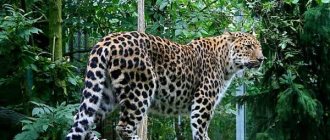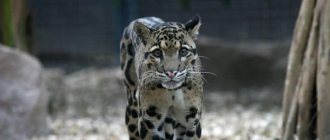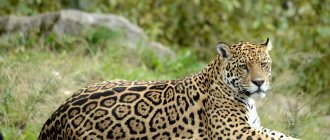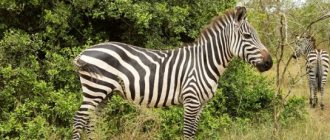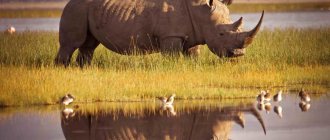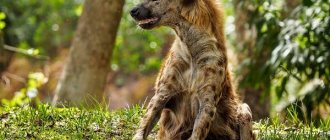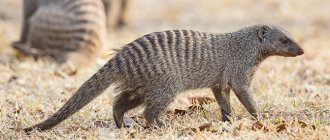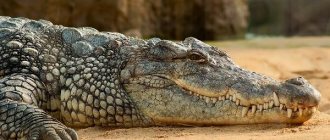The leopard is the most graceful and colorful member of the cat family. This extremely fast and dangerous predator belongs to the cat family and the panther genus. Leopards are notable for their spotted color, which allows them to camouflage well in their habitat. At the moment, most subspecies of leopards are listed in the Red Book as endangered species in need of protection.
Leopard subspecies
In total there are about 8 subspecies of leopards. Let's look at each of them in more detail:
Indochinese leopard
This representative is distinguished by its black color. The species numbers only 2,500 representatives. They live in southeast Asia. Until 2016, they inhabited Singapore, Cambodia and southern China. Due to widespread deforestation, poaching and trade, fur has become extremely rare.
Ceylon leopard
A fairly large subspecies of leopard with a body length of 142 centimeters and a weight of up to 77 kilograms. It lives on the island of Ceylon, which is commonly known as Sri Lanka. There are only 950 individuals in total.
North China leopard
It has a body length of up to 136 centimeters and a weight of about 75 kilograms. Inhabited the mountains and forests of the central and northeastern region of China. A very small species with populations of no more than 348 individuals.
Javan leopard
An endangered subspecies found in Indonesia on the island of Java. Mostly black in color, but sometimes spotted species are also found. The total population of this species is 525 representatives. Extinction occurs due to the reduction of their habitat.
South Arabian leopard
A small representative with a body length of up to 140 centimeters and a weight of 30 kilograms. Notable for its both pale and bright yellow body color. The rosettes on the fur have a patterned structure. For some time, the number of South Arabian leopards was widespread, but since 2008 there are no more than 200 species in the Arabian Peninsula.
Far Eastern leopard
It has several other names: Amur, Korean, Manchurian and East Siberian. The body size is 136 centimeters in length with a weight of no more than 75 kilograms. It differs from other representatives in its long and soft fur texture. During the cold season, the color changes to lighter than in the summer. The area of the lower torso and limbs are painted white. Distributed throughout China, North Korea and the Russian Federation. Literally a hundred years ago it inhabited the entire Korean Peninsula. In 2014 alone, there were 50 representatives of the species. Active measures are being taken to preserve and increase the size of the remaining population.
Persian leopard
This is a fairly large representative of the species with a body length of about 183 centimeters and a weight of up to 60 kilograms. It is distinguished by its dull grayish-orange fur color. The surface of the body is covered with sparse brown spots. Persian leopards have spread throughout Iran, Pakistan, Iran, Turkmenistan and Turkey. In total there are only 1290 representatives of the species. Previously, individuals spread throughout the North Caucasus, but completely disappeared in the mid-20th century.
African leopard
This is the most numerous subspecies. Its body size is about 180 centimeters in length with a weight of up to 90 kilograms. Populated, as the name suggests, the territory of Africa. It chooses various mountains, semi-deserts and tropics as its habitat.
Where does the Far Eastern leopard live?
Photo: Far Eastern Amur leopard
These wild cats adapt well to any terrain, so they can live in any natural conditions. At the same time, they avoid populated areas and places that people often visit.
Criteria for choosing a place of residence:
- rock formations with ledges, cliffs and outcrops;
- gentle and steep slopes with cedar and oak forests;
- roe deer population exceeding 10 individuals per 10 square kilometers;
- presence of other ungulates.
The best option for choosing a habitat is the middle and end of the water stream flowing into the Amur Bay and the area of the Razdolnaya River. This area extends over 3 thousand square kilometers, the altitude above sea level is 700 meters.
The abundance of ungulates in this territory is a favorable condition for the settlement of predators in this area, as well as uneven terrain, slight snow cover in winter and coniferous-deciduous forests in which black fir and Korean cedar grow.
In the 20th century, leopards lived in southeastern Russia, the Korean Peninsula and northeastern China. Due to human encroachment into their range, the latter was divided into 3 separate areas, which contributed to the creation of 3 isolated populations. Now leopards live in the mountainous and forested area between Russia, China and the DPRK with a length of 10 thousand square kilometers.
Black and white leopards
Sometimes there are black leopards, which are also called black panthers. Although their fur color is completely black, they also have spots that are lighter shades of black.
In addition to melanistic leopards, there are also representatives with incomplete melanism or abundism. The spots of this representative are very wide and can merge into one whole. Thus, the black color appears only in certain areas of the animal's fur.
In nature, there are also completely white leopards, which are also called albinos. They are endowed with blue eyes and white coat color, on which spots distinguishable by shade are slightly visible. They are found in southern China or India. Only a few such representatives have appeared in nature reserves around the world.
Habitats
The most densely populated areas where leopards live are forests and savannas. However, they give their choice to the trees.
Note!
- Euthanasia of animals.
- Spitz. Features of the breed.
Car hammock for dogs. What it is?
general description
Leopards are also called large cats. They are endowed with a very long and strong body, which is slightly narrowed at the sides. The head is small with a characteristic round shape. The ears are small and rounded. The average body size of leopards ranges from 90 to 190 centimeters in length with a tail ranging from 60 to 110 centimeters. The body weight of males ranges from 60 to 75 kilograms. The average weight of a female is almost two times less than the weight of a male.
The animals are remarkable for their characteristic color. Most subspecies do not change coat color depending on the time of year.
The main colors of leopards are yellow and red-yellow with small black spots.
How much does a leopard's "dinner" weigh?
The average weight of a leopard's prey is 25 - 50 kg. But this does not mean that the predator is ready to be content with small prey. The animal is able to cope with a zebra, deer or horse. But, if a cat is hungry, it does not disdain frogs, mice and fish. The leopard is a threat to all types of monkeys; they avoid meeting with it, and even the sight of the animal’s skin instills panic in the monkeys. An intelligent and cautious predator, even if there is an abundance of food, enters livestock farms, where livestock becomes its prey. This behavior of the leopard can only be explained by self-confidence: while avoiding meeting a person, it still goes after “easy” prey, hoping for its speed and power.
The leopard's perfect hunting skills allow it to camouflage perfectly, remaining unnoticed on a thick fork of a tree when the skin merges with the color of the bark, or sneak through the grass 30-40 cm high, hugging tightly to the ground. Only the tail can give an animal away: when the animal is excited, its tail hangs down and the tip twitches slightly. The leopard hides the captured trophy in a place inaccessible to jackals and wolves: on rocks or in the forks of trees. The advantage of climbing trees allows the predator to store a certain supply of food. He can eat up the remains of the “second freshness” dinner on the fourth or fifth day, but if another predator has touched his reserves, the cat will not touch the prey even if it is hungry.
Distribution area
The habitat of leopards is very wide. However, their numbers in many regions are extremely small. A wide population is distributed throughout Africa, as well as in Asia and some regions of the Arabian Peninsula. Black representatives can be found on the island of Java and Malacca.
Animals prefer vast forest spaces as a habitat. Tropical and deciduous forests, river thickets and mountain slopes are widely inhabited. Some subspecies are found in savannas, steppes and deserts. It is important for them to have some kind of shelter in which there is a sufficient amount of food and the absence of threats from people.
Population and species status
Scientists have noted a steady decline in the total number of leopards in the wild. The main factors that have a negative impact on the populations of these predators are human activity, which leads to a reduction in the food supply. The Javan leopard subspecies inhabiting the island of Java is on the verge of complete extinction.
The Ceylon leopard may face the same fate if serious steps are not taken to restore its numbers. The East Siberian leopard, the Central Asian and South Arabian leopards should be classified as an endangered species.
Nutrition
Leopards are absolutely predatory animals. They feed on a variety of roe deer, antelope and deer. Hunting for their prey is organized near bodies of water. In addition to artiodactyls, leopards can feed on the carcasses of hares, birds and some monkeys. During periods of lack of food, they do not hesitate to eat carrion.
Leopards tend to steal food from each other, since it can stay in the territory of another predator for a long time. As a rule, their shelters are located in root hollows of trees, on scattered stones and in rock overhangs.
Natural enemies
Wolves, being pack animals and large predators, pose a serious threat to leopards, especially in areas with insufficient trees. There have been clashes with bears, lions and tigers, as well as hyenas. The main enemy of leopards is humans.
Return to content
Lifestyle and behavior
Big cats are characterized by a solitary lifestyle. They are active at night and spend the day on trees. These predators are also notable for their ability to jump onto rocks and trees up to 5 meters in height. Thanks to their acute vision and hearing, they are excellent at navigating in the dark. And due to their color, they are well camouflaged in their habitat. The only thing that gives them away is their very long tail, which they do not know how to tuck under themselves. Females spend most of their lives with their offspring, while males are solitary throughout their lives.
Leopards are characterized by territorial behavior. The size of the territory of one female can range from 10 to 290 square kilometers, and the territory of a male can reach 1140 square kilometers. They mark their territory with urine and excrement. They also tend to peel off tree bark and make scrapings in the ground.
During the calm period, animals move at a light pace, but are capable of breaking loose, reaching speeds of 60 kilometers per hour. The predators' jumps are 3 meters high and 7 meters long. Leopards are also distinguished by their ability to swim quickly and overcome long distances in water.
What does the Far Eastern leopard eat?
Photo: Far Eastern leopard red book
The most active hunting hours are during the twilight hours and the first half of the night. In cloudy weather in winter, this can also happen during the day. They always hunt alone. Watching the prey from ambush, they creep up to it at 5-10 meters and with quick jumps overtake the prey, clinging to its throat.
If the prey was particularly large, leopards live near it for a week, protecting it from other predators. If a person approaches the carcass, wild cats will not attack or show aggression, but will simply return to the prey when the people leave.
Leopards are unpretentious when it comes to food and will eat everything they can catch. And it doesn’t matter what size the victim is.
It can be:
- young wild boars;
- roe deer;
- musk deer;
- spotted deer;
- hares;
- badgers;
- pheasants;
- insects;
- wapiti;
- birds.
Interesting fact: This type of leopard loves to eat dogs. Therefore, when entering the protected areas of the national park, there will definitely be a warning: “entry with dogs is prohibited.”
On average, leopards need one adult ungulate for several days. They can stretch out their meals for up to two weeks. If the population of ungulates is insufficient, the interval between their capture can be up to 25 days; the rest of the time, cats can snack on small animals.
To cleanse the stomach of hair (mostly its own, swallowed while washing), predators eat grass and cereal plants. Their feces contain up to 7.6% of plant residues that can cleanse the gastrointestinal tract.
Breeding period
It is common for southern representatives to reproduce throughout the year. The inhabitants of the Far East organize the mating season from late autumn to early winter. The mating season is characterized by long fights, which are accompanied by loud roars. The rest of the time the animals are very quiet and calm.
The incubation period lasts for 3 months. Childbirth occurs within 6 hours. From 1 to 3 cubs are born with a body weight of up to 700 grams and a length of up to 15 centimeters. Leopards are born completely blind and covered with thick, long, dark brown fur with spots. Babies develop hearing and vision at the age of one and a half weeks. If the mother senses a potential threat, she quickly hides her cubs away from danger. Already at the age of 6 weeks, leopards begin to leave the den.
Leopard cubs
At first, the mother feeds the offspring with semi-digested meat, and then begins to bring small birds and small mammals. The female cares for the offspring in a specially equipped den, which is located in caves, crevices or blind holes. It is noteworthy that small leopards meow like domestic cats.
The offspring spend time with their mother throughout the year. During this time, she teaches them hunting and survival skills in the wild. After leaving their mother, young leopards stay together for some time.
Animals become sexually mature at the age of two and a half years.
Night beast
During the day, representatives of large cats mostly sleep, but at night comes their time, the time for active hunting. A hungry leopard eats its prey in one or two days; if the animal is not hungry, it hides the remainder of its catch as a reserve for difficult times.
He chooses places for the cache that are inaccessible and remote - rocky caves or high and dense tree crowns.
Difference between leopard and jaguar
Leopard and jaguar can be confused. However, they have a number of characteristic differences by which one or another animal can be easily identified. The body of a jaguar is larger and stockier than the build of a leopard. Jaguars also have a much shorter tail, reaching a maximum of 91 centimeters in length, while in leopards it can reach up to 110 centimeters. Another difference is the structure of the head: in jaguars it is larger and more massive, and in the mouth there are large and wide jaws. You can quickly distinguish animals by color. The spots on a jaguar's body are much larger than those of a leopard. In addition, jaguars are distinguished by more saturated and brightly colored fur.
Photo of a jaguar
What the two species have in common is the prevalence of melanism. Leopard and jaguar can be completely black. The name "black panther" can refer equally to both the jaguar and the leopard.
Leopard's ancestors come from Asia
Studying the evolution of this species allows us to draw exactly this conclusion. The data was obtained mainly through the analysis of found fossil remains. Research in the field of molecular phylogenetics was also of great importance. Using fossil remains, the approximate time of the appearance of the leopard's ancestors was obtained - this happened about 3.8 million years ago. Data from molecular phylogenetic analysis fully confirm the presence of a close relationship between representatives of the genus Panthera. In addition, this kind of analysis allows us to conclude that the leopard separated from the common ancestral line much earlier than the jaguar and lion. Scientific publications record the fact that it was Asia that became the birthplace of the ancestor of the leopard. Later, he settled across the African continent. The origin of the modern leopard is believed to be between 470,000 and 825,000 years ago. Place of origin: Africa. A little later, the leopard also populated Asia.
Interesting Facts
- Leopards are considered iconic animals that received special fame among ancient peoples. In Asia, sanctuaries and shrines were built in their honor. Many African tribes considered leopards to be a sacred totem.
- Among leopards there are cannibals. As a rule, they are old and sick animals that are not able to hunt. In the 20s, a case called the “Rudaprayag cannibal” was recorded. In India, a leopard entered a village where it killed 125 people.
- The appearance of the leopard is similar to the Bengal cat. This type of cat is distinguished by its well-developed hunting instinct and formidable character.
Leopards are extremely interesting and mysterious representatives of the fauna, which have some interesting features in their history and way of life.
Panther
Many people mistakenly assume that the panther is a separate species of cat, although in fact it is still the same leopard, just different in color. Its fur contains a greater amount of pigment and due to this it appears that the panther is black.
But in fact, the black spots and rings characteristic of a leopard also appear against a dark background. Melanistic animals live mainly in the tropics.
Leopard is a desirable hunting trophy
Since ancient times, hunting for leopards has been carried out throughout the species’ habitat. The leopard was exterminated most massively in the last and century before last - the houses of aristocrats in different parts of the globe were often decorated with stuffed animals and leopard skins. Nowadays, hunting leopards is prohibited. In principle, the ban does not prevent poaching from flourishing, which covers many areas. Moreover, in some countries of the African continent there are legal hunting safaris, where absolutely anyone can freely hunt a leopard from ambush for a fee.
Man-eating leopards are sick or old individuals
Man-eating leopards are very, very rare. Indeed, these are predominantly sick or old individuals who are physiologically unable to hunt ungulates. For example, there is a known case (took place in the twenties of the last century) when one leopard from India had one hundred and twenty-five officially confirmed kills of people. The “Rudraprayag cannibal” acted as follows: under the cover of darkness, he entered villages and attacked people right in their huts or courtyards. In addition to old and sick leopards, representatives of this species who have suffered from porcupine quills and become disabled as a result can become cannibals. Such individuals lose mobility. The latter leads to the fact that the leopard is not able to hunt its usual prey and becomes a cannibal.
Tourists come to the rescue. Conservation in nature
Despite the fact that some subspecies of leopards may soon disappear, it is likely that the animal, which adapts well to any conditions and successfully hunts, will be able to safely survive in most of its current range. In some regions, the number of leopards is declining as a result of habitat changes due to human economic activities and the direct extermination of predators that attack livestock. However, even where leopards are shot quite frequently, populations of these animals generally remain stable.
People kill leopards not only to protect their livestock, but also for entertainment: in Africa, the leopard is one of the “Big Five” - this is the name given to a group of five species of animals, the representatives of which are favorite objects of sport hunting; the other four species are lion, buffalo, elephant and rhinoceros. The Convention on International Trade in Endangered Species of Wild Fauna and Flora (CITES) allocates annual trophy hunting quotas to countries that contribute to the maintenance of viable leopard populations.
